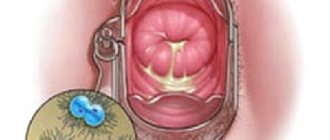Some people are sure that cystitis occurs due to hypothermia, others believe that it is due to microbes. Both are simultaneously right and wrong. Because both conditions are important for the development of the disease: the presence of a pathogen and a decrease in the body’s defenses.
Medical expert at the laboratory of personalized medicine LabQuest Nadezhda Bezemskaya.
This disease is considered to be “female,” but in fact, everyone can get cystitis, regardless of gender and age. However, women actually experience this disease 8 times more often than men.
Causes of the disease
Cystitis in women usually occurs due to the entry into the urethra of an aggressive conditionally pathogenic pathogen, as well as ascending sexually transmitted infections: chlamydia, ureaplasma (Ureaplasma), fungal infections of the genus Candida, etc. A short and wide urinary channel is often vulnerable to such infections. The occurrence of cystitis in women can also occur due to the movement of pathogens through the bloodstream. This path of disease development is called hematogenous.
Another variant of infection is the entry of bacteria into the bladder due to pathologies of the kidneys and ureters. Typically, this development of events can be observed with pyelonephritis.
Causes of cystitis
It should be noted that a less common, but still occurring variant of the development of the disease, provoked by anomalies in the development of the urinary system. Cystitis can also be caused by a decrease in the contractility of the bladder muscles.
It is also worth highlighting cystitis during menopause during atrophic processes in the mucosa.
Signs of infection may appear especially active in the presence of predisposing factors. These include:
- Sedentary work. Sitting for more than three hours at a time causes urine to stagnate, leading to possible bladder infection. Therefore, if your work involves sitting in one place for a long time, you need to get up every hour and do a short warm-up every three hours.
- Constipation.
- Presence of sand and stones in the bladder.
- Tight underwear that can disrupt normal blood circulation in the pelvic organs.
- Frequent hypothermia of the body.
- Lower back injuries, spinal cord injuries.
- Early onset of sexual activity.
- Metabolic disorders, hormonal changes in the body (for example, menopause or pregnancy). During hormonal surges, the body's immune system may malfunction. Please note: when carrying a child, the expectant mother is at particular risk in case of infection and development of cystitis. Therefore, during pregnancy, it is necessary to carefully monitor your own health and consult a doctor at the first signs of illness.
- Diabetes mellitus (Diabetes mellitus).
- Therapy with immunosuppressive drugs.
- Oncological diseases.
- Unbalanced and irregular diet: abuse of spicy and fried foods, alcohol.
- Improper hygiene procedures (in particular, improper washing in the direction from the anus to the vagina).
- The chance of bladder infection is high if personal hygiene is not carefully observed (wearing the same pad or tampon for a long time during menstruation, untimely change of underwear, constant use of panty liners).
- Stress, chronic lack of sleep, which has a serious impact on the immune system.
- A general decrease in immunity caused by the presence of a chronic source of inflammation in the body (stomatitis, caries, rhinitis, tonsillitis). As a result, this can lead to disruption of the sterility of the urethra
Separately, it is worth highlighting such a form of inflammation of the bladder as interstitial cystitis, which is a consequence of serious disorders in the functioning of the immune system and is a severe chronic disease.
Risk factors
There are many factors that contribute to the development of cystitis:
- hypothermia;
- decreased immunity;
- hypovitaminosis;
- poor nutrition. Spicy, salty, fried, fatty and alcoholic drinks irritate the walls of the bladder and dehydrate the body;
- violation of vaginal microflora;
- frequent and prolonged constipation;
- injuries to the bladder mucosa;
- sedentary lifestyle (poor circulation);
- tight clothing and synthetic underwear;
- the presence of chronic gynecological, urological or sexually transmitted diseases;
- previous urinary tract infections;
- failure to comply with personal hygiene rules;
- improper use of pads and tampons;
- constant lack of sleep, overwork, stress;
- promiscuity and unprotected sex;
- diabetes;
- hormonal disorders;
- previous operations;
- bladder catheterization;
- taking certain medications, for example, sulfonamides;
- genetic predisposition;
- pregnancy and childbirth;
- anatomical abnormalities, for example, phimosis in boys.
Symptoms and signs of cystitis
How does cystitis manifest?
The symptoms of cystitis are very characteristic and allow you to immediately make a correct diagnosis. First of all, this is a frequent urge to urinate (the patient visits the toilet up to several times per hour) and the manifestation of pain at the end of the process of emptying the bladder. Also, the most striking symptoms include:
- feeling of fullness of the bladder even after urination;
- blood or pus in the urine;
- urine with cystitis in women acquires a more pungent odor;
- cloudy urine and the presence of flakes in it;
- pain in the lower abdomen;
- when the infection spreads, including to the upper parts of the urinary system, pain in the kidneys and lower back is possible;
- quite rare, but difficulty in holding urine does occur
Prevention
- As a preventative measure, both partners should be sure to maintain good hygiene.
- Partners should avoid sexual positions that create pressure or friction on the urethra, as well as intense tempos.
- It is necessary to use special lubricants (lubricants) in case of natural deficiency of vaginal mucus.
- Provide timely treatment for gynecological diseases.
- Do not use spermicides or vaginal diaphragms for contraception.
- It is recommended to empty the bladder immediately after sexual intercourse, this allows you to “evacuate” most of the bacteria that have entered the bladder.
- Immediately after contact, drink at least 300 ml of liquid.
Video about bladder inflammation
Infectious disease doctor Vladimir Nikiforov talks about bladder inflammation. Source - Live Healthy!
If you discover these symptoms, you need to consult a doctor for diagnosis and further treatment, since the advanced form of the disease is fraught with a number of complications.
Expert opinion
Symptoms of cystitis cause a woman not only physical, but also psychological discomfort, leaving an imprint on her personal and social life. Therefore, it is necessary to react to the appearance of the first signs of the disease as early as possible and begin therapy.
Obstetrician-gynecologist of the highest category Oksana Anatolyevna Gartleb
If the inflammation caused by infection spreads to the muscle layer of the bladder, the appearance of interstitial cystitis, which was already mentioned above, may occur. In this case, urine penetrates the walls of the organ, as well as its reflux into the ureters.
symptoms of cystitis in women
If untreated and if the infection spreads vertically, kidney disease-pyelonephritis (Pyelonephritis) may develop.
doctor
Specialized multidisciplinary clinic
Our staff consists of high-class doctors - members of the Russian and European Societies (EA).
We have a day hospital
We guarantee constant care for the patient and control over his recovery in the most comfortable conditions.
Low-traumatic treatment methods
We carry out operations with minimal intervention in the body using modern equipment of the new generation of intraoperative X-ray systems.
Types of cystitis
It is necessary to distinguish between types of disease that differ in the method of occurrence, course, morphological changes and nature of spread.
All types of cystitis are divided according to the nature of the course into acute and chronic. We will consider both options for the course of the disease.
Acute cystitis
Against the background of the manifestation of the symptoms described above, acute cystitis gives low-grade fever and general malaise. The blood vessels of the bladder dilate, which leads to swelling of the walls of the organ. In this case, pinpoint hemorrhages and hyperemia (Hyperaemia) are observed. During the acute phase of the disease, the mucous and submucous membranes of the bladder usually suffer, and their epithelium is torn away in places, and blood may appear in the urine. The color of urine in the hemorrhagic form of the disease can vary from light pink to cloudy brown.
Chronic cystitis
When the disease enters the chronic phase, inflammation expands and moves from the mucous and submucous membranes to the muscular layer of the bladder. In this case, the color of the mucous membrane acquires a whitish or grayish tint. If the disease is not treated for a long period of time, sclerotic processes appear in the organ, due to which its volume may decrease.
In the chronic form, all the previously mentioned signs can be “blurred” and not clearly expressed, which makes diagnosis difficult. If chronic cystitis is suspected, it is necessary to rely on data from the anamnesis, macro- and microscopy of urine, cystoscopy, and bacteriological examination. Particularly important when identifying chronic cystitis is a parallel gynecological examination, since often it is genital infections that cause the appearance of chronic forms of cystitis.
Acute and chronic cystitis: which doctor should I contact?
Standard tests for diagnosing cystitis in older women, mature women and girls are a general urine test, urine culture to identify pathological flora (bacteriuria), Nechiporenko analysis. As additional measures, modern clinics often offer ultrasound of the bladder and kidneys, cystoscopy, and screening for STIs. In some cases, the doctor may order urine collection for analysis not using the standard method, but using a catheter. This may be necessary to prevent vaginal discharge from entering the urine.
Diagnostics
Correct diagnosis of cystitis directly affects the success of treatment of the disease. It is important to establish the nature and factors of inflammation before prescribing therapy. If allergic cystitis occurs and contact with the allergen is not eliminated before taking antibiotics, the condition will only worsen.
In the case of infectious cystitis, it is necessary to determine its causative agent and establish which antimicrobial or antifungal drugs it is sensitive to. The result of the study will determine the course of further therapy. If cystitis is non-infectious in nature, it is necessary to conduct an examination to determine the causes that triggered the onset of the disease. Perhaps the cause is urolithiasis or a neoplasm.
Diagnosis of the disease includes the following stages:
- taking anamnesis;
- determination of clinical manifestations;
- appointment of laboratory tests;
- examination using instrumental methods.
Treatment of cystitis
Treatment of acute cystitis is based on antibacterial drugs. Due to the fact that such drugs are excreted by the kidneys, it is very easy to achieve the required concentration of the antibiotic in the bladder, so the effect of treatment appears as quickly as possible. There are two important factors to consider:
The doctor should prescribe antibiotics after receiving urine culture results, which will determine the sensitivity of the pathogen to the chosen drug.
Even after the condition has been alleviated, the prescribed course of antibiotics must be taken to the end, which will avoid relapse and the disease becoming chronic.
The following are used as auxiliary measures for the treatment of cystitis:
- drugs to relieve bladder spasms, general anti-inflammatory drugs;
- physiotherapy;
- ozone therapy;
- acupuncture.
To treat chronic cystitis, local administration of drugs that prevent the proliferation of pathogenic microorganisms can also be used. Restoring gel “Gynocomfort” with tea tree essential oil can be used as an adjuvant. This product was developed by specialists of the pharmaceutical company VERTEX, passed clinical studies at the Department of Dermatovenereology with the clinic of St. Petersburg State Medical University and has the necessary documents and quality certificates. The gel is recommended for eliminating vaginal discomfort, normalizing microflora and restoring the vaginal mucosa after infectious and inflammatory diseases and in the period after treatment with antibiotics.
Acute cystitis
It is worth noting that the treatment of acute cystitis always involves bed rest. Treating the inflammatory process in the bladder “on the run” without issuing a sick leave, especially in the cold season, means risking the possible transition of the disease to a chronic form. The disease is always accompanied by severe stress for the body, which requires rest and rest. At the same time, ignoring the disease and postponing a visit to the doctor can “result” in pyelonephritis, the treatment of which will require constant medical supervision.
More information about drug treatment of cystitis in women: drugs
Some of these medications are usually prescribed to relieve symptoms and treat cystitis in women:
"Monural". This drug has an antibacterial effect on most gram-positive bacteria. The main active ingredient of the drug is fosfomycin. "Monural" is prescribed starting from the age of five, and is contraindicated in cases of severe renal failure.
Furagin. An antimicrobial drug that is well tolerated by patients. It effectively fights the action of many harmful microorganisms, including staphylococci and E. coli. Please note that Furagin has contraindications, including pregnancy and renal failure.
Antibiotics and quinolones. These medications for cystitis in women have a wide spectrum of action, so they are prescribed not only for the treatment of cystitis and effectively fight a number of STIs, streptococci, and staphylococci. Use only after prior consultation with a doctor.
Monurel. This remedy is usually prescribed as a preventive measure (especially in the case of frequent exacerbations of the disease). The main active ingredient is cranberry extract, which suppresses the action of microbes in the walls of the bladder.
Cyston. Belongs to the category of herbal preparations. The composition includes a complex of ten plants (didimocarpus cauliflower, membranous rash, madder cordifolia, saxifraga reed and others) that help relieve inflammation during female cystitis. Has antispasmodic and diuretic effects.
Cardiologist German Gandelman on the causes of female cystitis. Source - cystis.ru
Treatment of cystitis at home
Treating cystitis at home can be very effective. Of course, home treatments do not exclude visiting a doctor and the need for tests, but they will help relieve unpleasant symptoms and pain.
Bearberry decoction shows excellent effectiveness, which is confirmed by experienced nephrologists. This herb has a diuretic effect and effectively removes “bad” flora from the bladder.
Cranberry juice is also recommended for use, which, due to its acidic environment, prevents the proliferation of microorganisms. At the first manifestations of cystitis symptoms, you can take a decoction of lingonberries, bear's ear, and half-palm.
Therapeutic diet
In order to relieve inflammation as quickly as possible, it is recommended to drink plenty of fluids: the minimum volume of liquid consumed should be 1.5 liters per day.
It is also necessary to follow a diet.
Nutrition for cystitis has a number of restrictions. Eliminating hot and spicy foods will promote recovery and help avoid a recurrence of the situation. During the treatment period, it is necessary to completely avoid alcohol. This applies to all alcohol-containing drinks.
If you notice painful and frequent urination, blood, flakes or pus in your urine, do not rush to panic. Indeed, according to statistics, female cystitis is a very common phenomenon.
The main thing is not to delay and consult a doctor in time.
Sources:
- ISSUES OF DIFFERENTIAL DIAGNOSIS AND TREATMENT TACTICS OF ACUTE UNCOMPLICATED CYSTITIS IN WOMEN IN PRIMARY CARE. Akilov F.A., Arustamov D.L., Alidzhanov Zh.F., Rakhmonov O.M., Mirkhamidov D.Kh. // Bulletin of emergency medicine. – 2011. – No. 1. – P.106-110.
- CURRENT ASPECTS OF PHARMACOTHERAPY OF CHRONIC CYSTITIS IN THE ACUTE STAGE IN WOMEN. Kurnosova N.V., Kuzmenko A.V., Kuzmenko V.V. // Saratov Scientific and Medical Journal. – 2010. – No. 3. – pp. 705-708.
- Diagnosis and treatment of interstitial cystitis. Zaitsev A.V. // Author's abstract. dis. Dr. med. Sci. M. - 1999. P. 38.
- Results of studying the prevalence of antibiotic resistance among pathogens of community-acquired urinary tract infections. Sidorenko S.V., Ivanov D.V. // Antibiotics and chemotherapy. - 2005. No. 5091. - P. 3-10.
- Uncomplicated and complicated urinary tract infections. Principles of antibacterial therapy. Lopatkin N.A.. Derevyanko I.I. // Russian medical journal. - 1997. - T. 5, No. 24. P. 1579-1589.
- https://www.pubfacts.com/detail/23276554/Treatment-of-interstitial-cystitis-in-women
- https://www.researchgate.net/publication/44614433_Bacterial_cystitis_in_women/link/0c960517f54b1f402…
- https://www.aafp.org/afp/2009/0315/p503.html
- https://www.healthline.com/health/cystitis
Popular questions
Hello.
I have cystitis at an early stage, I started taking medications, curdled, I would even say, liquid discharge appeared, what could this be connected with? There is no pain, no irritation, no discomfort either. I was worried about the appearance of discharge... Hello! Cystitis is an inflammatory disease caused by specific or nonspecific microorganisms. In this case, the infectious factor can spread not only in the urinary system, but also in the reproductive system. Therefore, discharge from the genital tract appeared. For successful treatment, consult a doctor and determine the infection. This will allow you to prescribe rational treatment. At this stage, you can use Gynocomfort gel with tea tree oil. It contains medicinal herbs, bisabolol, which has an anti-inflammatory effect, and lactic acid will replenish the balance of the pH of the environment and lactobacilli. The gel is used in 1 dose 1 time per day for 7-14 days.
Hello, I am diagnosed with chronic cystitis. Relapses every year. I donated urine. Leukocytes were elevated 10-12. Now the culture and urine tests are ideal. Ultrasound of the bladder and kidneys also revealed nothing. She was treated with Monural (2 packets), then with norfolaxicin (10 days). The acute pain went away, but the itching, burning sensation and nagging pain after going to the toilet after bowel movements remained. And before the relapse, there was frequent urination, it felt like the bladder was constantly full even after urinating. Tell me what tests need to be taken and what they are called. If you take it in a private laboratory, what narrower tests should you undergo and which doctors should you contact? What do you need to go through? I was going to get pregnant... And how to support the body before taking tests so that acute pain does not return? I am now drinking furadonin, herbs, cystone, phytolysin. Thank you in advance.
Hello! This is a disease of the urinary system, so examination, treatment and rehabilitation before planning pregnancy should be done by a urologist.
Hello! I take Furamag and Canephron in parallel for cystitis, the question is, is it possible to take Canephron during menstruation? As far as I know, lovage is not recommended for uterine bleeding, but it is part of Canephron, nothing is written in the contraindications, but I decided it was better to ask a specialist, thanks in advance for the answer!
Hello! The drug Canephron contains a combination of several medicinal herbs in therapeutic doses, so there will be no increase in the volume of menstruation or uterine bleeding. The drug can be taken during menstruation.
Good afternoon, Oksana Anatolyevna! I was tormented by cystitis after PA, discomfort (irritation) during and after PA, opportunistic flora, cystoscopy results were good. Which gel is better to use?
Hello!
Postcoital cystitis most often develops due to lack of hydration of the genital organs and microtrauma of the mucous membranes. I recommend using Ginocomfort gel with mallow extract before contact as a lubricant and prophylactic agent. The frequency and duration of use are not limited. For an accurate diagnosis, contact a specialist









